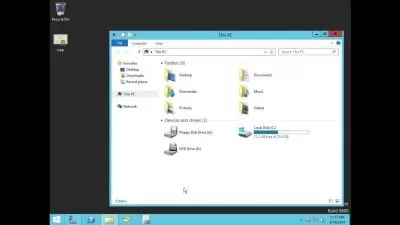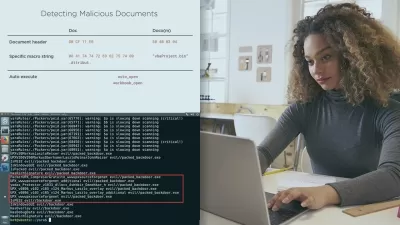Ethical Hacking For Beginners In Plain English
Corels Emmanuel
7:27:54
Description
A Complete guide to cyber hacking and safeguarding organizations, its systems, and networks.
What You'll Learn?
- An Overview Of Ethical Hacking & Penetration Testing.
- Basic Networking Fundamentals
- Emulating Real World Attacks In A Virtual Environment
- Useful Kali Linux Tools for Penetration Testing
- Linux Basics
- Penetration Testing Methods
- Legal Considerations For Pen Testers
- How To Write Effective Pen Test Reports
- Reconnaissance - Passive and Active
- Scanning and Enumeration
- Methods For Gaining Access
- Sending Automated Payloads and Exploitation
- Brute Force Attacks
- Password Spraying Attacks
- Reverse and Bind Shell
- Credential Stuffing
- Tips for Maintaining Access and Covering Tracks
- Web Server Vulnerabilities
- Handy Python Programming Skills
- Using Github
Who is this for?
What You Need to Know?
More details
DescriptionEthical hacking is different from hacking only in terms of intent. It is a profession where hacking methods are used to help organizations in preparing for impending cyber attacks. Unlike hacking, ethical hacking is used with good intent to help individuals and organizations and serves a greater purpose of securing important data and networks from malicious hackers.
Ethical hackers strengthen the network and system security by exploiting existing vulnerabilities. They identify the weaknesses and rectify them with appropriate and effective countermeasures. The techniques that ethical hackers follow are the same as those followed by the notorious ones. They only offer their services when they are legally hired by an organization to do so.
In this concise and practical course, You will be given a hand-on approach to becoming an ethical hacker, no matter your current skill level. The curriculum is designed for absolute beginners interested in a career as a security professional, beginning with the absolute basics of penetration testing, and progressing to advanced topics and techniques. Get started today in your Ethical Hacking career.
The increasing amount of high-profile cyber incidents continues to emphasize the need for individuals with these skills, with job demand projected to continue at an exponential rate.
The techniques shown here leverage free tools which are explained throughout the course, including instructions for creating your own home lab for practice and study. One of the primary tools you will become familiar with is Kali Linux, which is a Debian-based Linux distribution aimed at penetration testing and security auditing.
This course explores the following topics and more:
- Networking Basics
- Creating a Virtual Lab
- Kali Linux Tools for Penetration Testing
- Linux Basics
- Python Basics
- Penetration Testing Methodology
- Legal Considerations
- Report Writing
- Passive and Active Reconnaissance
- Scanning and Enumeration
- Reverse and Bind Shell
- Automated Payloads and Exploitation
- Brute Force Attacks
- Credential Stuffing
- Password Spraying
- Tips for Maintaining Access and Covering Tracks
- Web Server Vulnerabilities (As Outlined By OWASP)
Who this course is for:
- IT professionals interested in diversifying or updating their skill set
- Anyone IT enthusiast keen on network security topics and online security.
- Security Professionals of startups
Ethical hacking is different from hacking only in terms of intent. It is a profession where hacking methods are used to help organizations in preparing for impending cyber attacks. Unlike hacking, ethical hacking is used with good intent to help individuals and organizations and serves a greater purpose of securing important data and networks from malicious hackers.
Ethical hackers strengthen the network and system security by exploiting existing vulnerabilities. They identify the weaknesses and rectify them with appropriate and effective countermeasures. The techniques that ethical hackers follow are the same as those followed by the notorious ones. They only offer their services when they are legally hired by an organization to do so.
In this concise and practical course, You will be given a hand-on approach to becoming an ethical hacker, no matter your current skill level. The curriculum is designed for absolute beginners interested in a career as a security professional, beginning with the absolute basics of penetration testing, and progressing to advanced topics and techniques. Get started today in your Ethical Hacking career.
The increasing amount of high-profile cyber incidents continues to emphasize the need for individuals with these skills, with job demand projected to continue at an exponential rate.
The techniques shown here leverage free tools which are explained throughout the course, including instructions for creating your own home lab for practice and study. One of the primary tools you will become familiar with is Kali Linux, which is a Debian-based Linux distribution aimed at penetration testing and security auditing.
This course explores the following topics and more:
- Networking Basics
- Creating a Virtual Lab
- Kali Linux Tools for Penetration Testing
- Linux Basics
- Python Basics
- Penetration Testing Methodology
- Legal Considerations
- Report Writing
- Passive and Active Reconnaissance
- Scanning and Enumeration
- Reverse and Bind Shell
- Automated Payloads and Exploitation
- Brute Force Attacks
- Credential Stuffing
- Password Spraying
- Tips for Maintaining Access and Covering Tracks
- Web Server Vulnerabilities (As Outlined By OWASP)
Who this course is for:
- IT professionals interested in diversifying or updating their skill set
- Anyone IT enthusiast keen on network security topics and online security.
- Security Professionals of startups
User Reviews
Rating
Corels Emmanuel
Instructor's Courses
Udemy
View courses Udemy- language english
- Training sessions 79
- duration 7:27:54
- English subtitles has
- Release Date 2024/02/03









